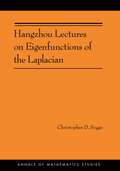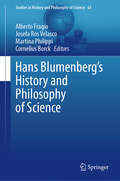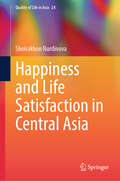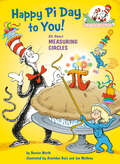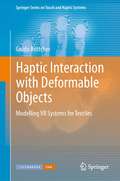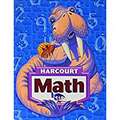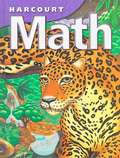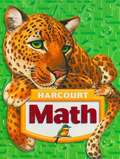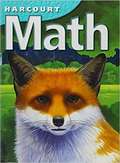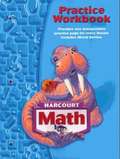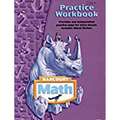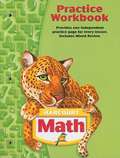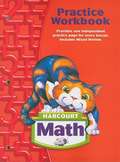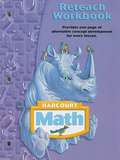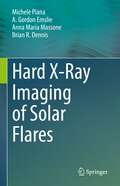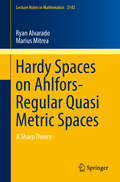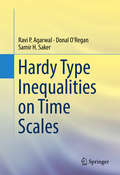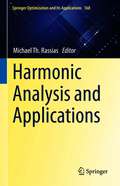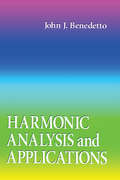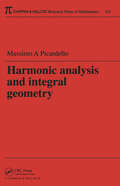- Table View
- List View
Hangzhou Lectures on Eigenfunctions of the Laplacian (Annals of Mathematics Studies #188)
by Christopher D. SoggeBased on lectures given at Zhejiang University in Hangzhou, China, and Johns Hopkins University, this book introduces eigenfunctions on Riemannian manifolds. Christopher Sogge gives a proof of the sharp Weyl formula for the distribution of eigenvalues of Laplace-Beltrami operators, as well as an improved version of the Weyl formula, the Duistermaat-Guillemin theorem under natural assumptions on the geodesic flow. Sogge shows that there is quantum ergodicity of eigenfunctions if the geodesic flow is ergodic.Sogge begins with a treatment of the Hadamard parametrix before proving the first main result, the sharp Weyl formula. He avoids the use of Tauberian estimates and instead relies on sup-norm estimates for eigenfunctions. The author also gives a rapid introduction to the stationary phase and the basics of the theory of pseudodifferential operators and microlocal analysis. These are used to prove the Duistermaat-Guillemin theorem. Turning to the related topic of quantum ergodicity, Sogge demonstrates that if the long-term geodesic flow is uniformly distributed, most eigenfunctions exhibit a similar behavior, in the sense that their mass becomes equidistributed as their frequencies go to infinity.
Hank Greenberg in 1938: Hatred and Home Runs in the Shadow of War
by Ron Kaplan"Hammerin’” Hank Greenberg was coming off a stellar season where he’d hit 40 home runs and 184 RBIs, becoming only the thirteenth player to ever hit 40 or more homers (and one of only four players to have 40 or more home runs and 175 or more RBIs in a season). Even with his success at the plate, neither Greenberg nor the rest of the world could have expected what was about to happen in 1938. From his first day in the big leagues, the New York-born Greenberg had dealt with persecution for being Jewish. From teammate Jo-Jo White asking where his horns were to the verbal abuse from bigoted fans and the media, the 6-foot-3 slugger always did his best to shut the noise out and concentrate on baseball. But in 1938, that would be more difficult then he could have ever imagined.While Greenberg was battling at the plate, his people overseas were dealing with a completely different battle. Adolf Hitler, who had been chancellor of Germany since 1933, had taken direct control of the country’s military in February of ’38. He then began his methodic takeover of all neighboring countries, spreading Nazism and the early stages of World War II and the Holocaust.Hank Greenberg in 1938 chronicles the events of 1938, both on the baseball diamond and the streets of Europe. As Greenberg’s bat had him on course for Babe Ruth’s home run record, Hitler’s "Final Solution” was beginning to take shape. Jews across the US, worried about the issues overseas, looked to Greenberg as a symbol of hope. Though normally hesitant to speak about the anti-Semitism he dealt with, the slugger still knew the role he was playing for so many of his people, saying "I came to feel that if I, as a Jew, hit a home run, I was hitting one against Hitler.”
Hans Blumenberg's History and Philosophy of Science (Studies in History and Philosophy of Science #63)
by Cornelius Borck Josefa Ros Velasco Alberto Fragio Martina PhilippiThis book highlights and develops a hitherto neglected area of Hans Blumenberg's contributions, i.e., history and philosophy of science. It covers both Blumenberg’s works on the history of ideas and conceptual change, as well as his studies on transformative periods and his intellectual history of technology. Hans Blumenberg (1920-1996) was one of the leading German philosophers after the Second World War, bridging from the continental tradition of philosophy, conceptual history and metaphorology. This volume, though, explores the methodological instruments that he developed and how we may use them to do history and philosophy of science. In doing so it opens up a new field of research and provides insight into further developing a continental history and philosophy of science, making this book of great interest to both historians and philosophers alike.
Happiness and Life Satisfaction in Central Asia (Quality of Life in Asia #24)
by Shoirakhon NurdinovaThis book offers the first comprehensive examination of life satisfaction and happiness in Central Asia from an empirical and comparative perspective. Drawing on econometric models, it reveals how economic conditions, gender, culture, and social norms shape subjective well-being in Kazakhstan, Kyrgyzstan, Tajikistan, Turkmenistan, and Uzbekistan. The findings provide insights into the complex structure of quality of life in a region that has received little attention in happiness research. As such, the book makes a pioneering contribution to the study of well-being in Central Asia and serves as a valuable resource for scholars, policymakers, and researchers interested in happiness-oriented development and the determinants of well-being worldwide.
Happiness and Wellbeing in Singapore: Beyond Economic Prosperity (Routledge Focus on Business and Management)
by Siok Kuan Tambyah Soo Jiuan Tan Yuen Wei LunTo present a multifaceted and holistic perspective of what makes Singaporeans happy, Tambyah, Tan and Yuen discuss the findings and insights from the 2022 Quality of Life Survey, which examines the perceptions and views of 1,905 Singapore citizens. This is the latest survey in a series of studies on the wellbeing of Singaporeans. While the impact of the COVID- 19 pandemic on wellbeing is a timely discussion, the findings are also compared with previous surveys conducted in 2011 and 2016 to provide a longitudinal perspective of how Singaporeans’ wellbeing has evolved over the years. Key aspects of this topic include life satisfaction and satisfaction with specific life domains, aspects of affective wellbeing (e.g., happiness, enjoyment and achievement), economic wellbeing, psychological flourishing, personal values, value orientations and views on socio- political issues. Pertinent differences due to demographics such as gender, marital status, age, education and household income are also highlighted. The book also features four archetypes and clusters of Singaporeans, which are representative of the unique demographics, values and wellbeing outcomes examined. The findings and insights will be useful to academics, policy makers, practitioners, students and the general public who are interested in understanding the life satisfaction and wellbeing of Singaporeans.
Happy Pi Day to You! All About Measuring Circles (The Cat in the Hat's Learning Library)
by Bonnie WorthLaugh and learn with fun facts about the history of pi, measurements, theorems, and more—all told in Dr. Seuss&’s beloved rhyming style and starring the Cat in the Hat! &“It is all about circles and measuring fun. So put on your Pi Hats! Let&’s start, everyone!&” The Cat in the Hat&’s Learning Library series combines beloved characters, engaging rhymes, and Seussian illustrations to introduce children to non-fiction topics from the real world! Go on an adventure with the Cat in the Hat and learn: how to measure and draw circleshow pi is a number so long that it never endshow Ancient Egyptians used pi to help build the pyramidsand much more!Perfect for story time and for the youngest readers, Happy Pi Day to You! All About Measuring Circles also includes an index, glossary, and suggestions for further learning. Look for more books in the Cat in the Hat&’s Learning Library series!High? Low? Where Did It Go? All About Animal CamouflageIs a Camel a Mammal? All About MammalsThe 100 Hats of the Cat in the Hat: A Celebration of the 100th Day of SchoolA Great Day for Pup: All About Wild BabiesWould You Rather Be a Pollywog? All About Pond LifeI Can Name 50 Trees Today! All About TreesFine Feathered Friends: All About BirdsMy, Oh My--A Butterfly! All About ButterfliesOh Say Can You Seed? All About Flowering PlantsInside Your Outside! All About the Human BodyIce is Nice! All About the North and South Poles
Haptic Interaction with Deformable Objects
by Guido BöttcherThe focus from most Virtual Reality (VR) systems lies mainly on the visual immersion of the user. But the emphasis only on the visual perception is insufficient for some applications as the user is limited in his interactions within the VR. Therefore the textbook presents the principles and theoretical background to develop a VR system that is able to create a link between physical simulations and haptic rendering which requires update rates of 1\,kHz for the force feedback. Special attention is given to the modeling and computation of contact forces in a two-finger grasp of textiles. Addressing further the perception of small scale surface properties like roughness, novel algorithms are presented that are not only able to consider the highly dynamic behaviour of textiles but also capable of computing the small forces needed for the tactile rendering at the contact point. Final analysis of the entire VR system is being made showing the problems and the solutions found in the work
Harcourt Math (California Edition)
by Harcourt School PublishersThis book makes a student enjoy learning math and to feel confident that he CAN DO. The unit lessons of the book contain: Understand Numbers and Operations, Data, Graphing, and Time, Multiplication and Division Facts, Multiply by 1- and 2-Digit Numbers, Divide by 1- and 2-Digit Divisors, Fractions and Decimals, Measurement, Algebra, and Graphing, Geometry, and Probability.
Harcourt Math (Grade #6)
by Evan M. MaletskyThe authors of Harcourt Math want you to be a good mathematician, but most of all we want you to enjoy learning math and feel confident that you can do it. We invite you to share your book with family members. Take them on a guided tour through your book!
Harcourt Math: Level 5 (Harcourt School Publishers Math Ser.)
by Harcourt School Publishers StaffThe authors of Harcourt Math want you to enjoy learning math and to feel confident that you can do it. We invite you to share your math book with family members. Take them on a guided tour through your book!
Harcourt Math: Practice Workbook (Grade #3)
by Harcourt School PublishersA Grade 3 Math practice book.
Harcourt Math: Practice Workbook (Grade #4)
by Harcourt School PublishersA grade four mathematics book.
Harcourt Math: Practice Workbook (Grade #5)
by Harcourt School PublishersWrite and solve an equation for each problem. Explain what the variable represents.
Harcourt Math: Practice Workbook (Grade Two)
by Harcourt School PublishersThe math practice workbook for grade two deals with numbers and operations, digit addition and subtraction, money, time and data, geometry and patterns, and measurements and fractions.
Harcourt Math: Reteach Workbook (Grade #4)
by HarcourtThis Reteach Workbook for Grade 4 contains: Understand Whole Numbers and Operations, Time, Data, and Graphing, Multiplication and Division Facts, Multiply By 1- and 2-Digit Numbers, Divide By 1- and 2-Digit Divisors, Geometry and Algebra, Fractions and Probability, Measurement and Decimals, Perimeter, Area, and Volume, etc.
Hard X-Ray Imaging of Solar Flares
by Michele Piana A. Gordon Emslie Anna Maria Massone Brian R. DennisThe idea for this text emerged over several years as the authors participated in research projects related to analysis of data from NASA's RHESSI Small Explorer mission. The data produced over the operational lifetime of this mission inspired many investigations related to a specific science question: the when, where, and how of electron acceleration during solar flares in the stressed magnetic environment of the active Sun.A vital key to unlocking this science problem is the ability to produce high-quality images of hard X-rays produced by bremsstrahlung radiation from electrons accelerated during a solar flare. The only practical way to do this within the technological and budgetary limitations of the RHESSI era was to opt for indirect modalities in which imaging information is encoded as a set of two-dimensional spatial Fourier components. Radio astronomers had employed Fourier imaging for many years. However, differently than for radio astronomy, X-ray images produced by RHESSI had to be constructed from a very limited number of sparsely distributed and very noisy Fourier components. Further, Fourier imaging is hardly intuitive, and extensive validation of the methods was necessary to ensure that they produced images with sufficient accuracy and fidelity for scientific applications.This book summarizes the results of this development of imaging techniques specifically designed for this form of data. It covers a set of published works that span over two decades, during which various imaging methods were introduced, validated, and applied to observations. Also considering that a new Fourier-based telescope, STIX, is now entering its nominal phase on-board the ESA Solar Orbiter, it became more and more apparent to the authors that it would be a good idea to put together a compendium of these imaging methods and their applications. Hence the book you are now reading.
Hardy Spaces on Ahlfors-Regular Quasi Metric Spaces
by Marius Mitrea Ryan AlvaradoSystematically constructing an optimal theory, this monograph develops and explores several approaches to Hardy spaces in the setting of Alhlfors-regular quasi-metric spaces. The text is divided into two main parts, with the first part providing atomic, molecular, and grand maximal function characterizations of Hardy spaces and formulates sharp versions of basic analytical tools for quasi-metric spaces, such as a Lebesgue differentiation theorem with minimal demands on the underlying measure, a maximally smooth approximation to the identity and a Calderon-Zygmund decomposition for distributions. These results are of independent interest. The second part establishes very general criteria guaranteeing that a linear operator acts continuously from a Hardy space into a topological vector space, emphasizing the role of the action of the operator on atoms. Applications include the solvability of the Dirichlet problem for elliptic systems in the upper-half space with boundary data from Hardy spaces. The tools established in the first part are then used to develop a sharp theory of Besov and Triebel-Lizorkin spaces in Ahlfors-regular quasi-metric spaces. The monograph is largely self-contained and is intended for mathematicians, graduate students and professionals with a mathematical background who are interested in the interplay between analysis and geometry.
Hardy Spaces: Elements Of Advanced Analysis (Cambridge Studies in Advanced Mathematics #179)
by Nikolaï NikolskiThe theory of Hardy spaces is a cornerstone of modern analysis. It combines techniques from functional analysis, the theory of analytic functions and Lesbesgue integration to create a powerful tool for many applications, pure and applied, from signal processing and Fourier analysis to maximum modulus principles and the Riemann zeta function. This book, aimed at beginning graduate students, introduces and develops the classical results on Hardy spaces and applies them to fundamental concrete problems in analysis. The results are illustrated with numerous solved exercises that also introduce subsidiary topics and recent developments. The reader's understanding of the current state of the field, as well as its history, are further aided by engaging accounts of important contributors and by the surveys of recent advances (with commented reference lists) that end each chapter. Such broad coverage makes this book the ideal source on Hardy spaces.
Hardy Type Inequalities on Time Scales
by Ravi P. Agarwal Donal O'Regan Samir H. SakerThe book is devoted to dynamic inequalities of Hardy type and extensions and generalizations via convexity on a time scale T. In particular, the book contains the time scale versions of classical Hardy type inequalities, Hardy and Littlewood type inequalities, Hardy-Knopp type inequalities via convexity, Copson type inequalities, Copson-Beesack type inequalities, Liendeler type inequalities, Levinson type inequalities and Pachpatte type inequalities, Bennett type inequalities, Chan type inequalities, and Hardy type inequalities with two different weight functions. These dynamic inequalities contain the classical continuous and discrete inequalities as special cases when T = R and T = N and can be extended to different types of inequalities on different time scales such as T = hN, h > 0, T = qN for q > 1, etc. In this book the authors followed the history and development of these inequalities. Each section in self-contained and one can see the relationship between the time scale versions of the inequalities and the classical ones. To the best of the authors' knowledge this is the first book devoted to Hardy-type inequalities and their extensions on time scales.
Harmonic Analysis and Applications (Springer Optimization and Its Applications #168)
by Michael Th. RassiasThis edited volume presents state-of-the-art developments in various areas in which Harmonic Analysis is applied. Contributions cover a variety of different topics and problems treated such as structure and optimization in computational harmonic analysis, sampling and approximation in shift invariant subspaces of L2(ℝ), optimal rank one matrix decomposition, the Riemann Hypothesis, large sets avoiding rough patterns, Hardy Littlewood series, Navier–Stokes equations, sleep dynamics exploration and automatic annotation by combining modern harmonic analysis tools, harmonic functions in slabs and half-spaces, Andoni –Krauthgamer –Razenshteyn characterization of sketchable norms fails for sketchable metrics, random matrix theory, multiplicative completion of redundant systems in Hilbert and Banach function spaces. Efforts have been made to ensure that the content of the book constitutes a valuable resource for graduate students as well as senior researchers working on Harmonic Analysis and its various interconnections with related areas.
Harmonic Analysis and Applications: Mathematics And Applications (Studies In Advanced Mathematics Ser. #23)
by John J. BenedettoHarmonic analysis plays an essential role in understanding a host of engineering, mathematical, and scientific ideas. In Harmonic Analysis and Applications, the analysis and synthesis of functions in terms of harmonics is presented in such a way as to demonstrate the vitality, power, elegance, usefulness, and the intricacy and simplicity of the subject. This book is about classical harmonic analysis - a textbook suitable for students, and an essay and general reference suitable for mathematicians, physicists, and others who use harmonic analysis.Throughout the book, material is provided for an upper level undergraduate course in harmonic analysis and some of its applications. In addition, the advanced material in Harmonic Analysis and Applications is well-suited for graduate courses. The course is outlined in Prologue I. This course material is excellent, not only for students, but also for scientists, mathematicians, and engineers as a general reference. Chapter 1 covers the Fourier analysis of integrable and square integrable (finite energy) functions on R. Chapter 2 of the text covers distribution theory, emphasizing the theory's useful vantage point for dealing with problems and general concepts from engineering, physics, and mathematics. Chapter 3 deals with Fourier series, including the Fourier analysis of finite and infinite sequences, as well as functions defined on finite intervals. The mathematical presentation, insightful perspectives, and numerous well-chosen examples and exercises in Harmonic Analysis and Applications make this book well worth having in your collection.
Harmonic Analysis and Integral Geometry (Chapman & Hall/CRC Research Notes in Mathematics Series)
by Massimo A PicardelloComprising a selection of expository and research papers, Harmonic Analysis and Integral Geometry grew from presentations offered at the July 1998 Summer University of Safi, Morocco-an annual, advanced research school and congress. This lively and very successful event drew the attendance of many top researchers, who offered both individual lecture
